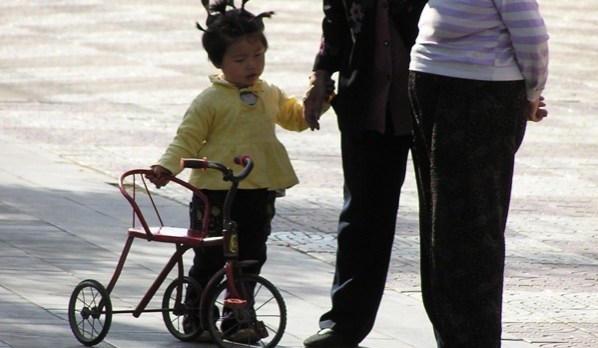People tend to be shocked by photos illustrating the level of air pollution in some cities in China (or in other parts of the world), with a gray sky and a thick layer of smog covering everything, thanks to excessively high levels of fine toxic particles.
Although the situation has improved in recent years, the levels of contamination are still above the limits established by the World Health Organization (WHO). In Hong Kong, a few years ago, they even set up large cardboard or cloth backdrops with the most panoramic photos of the city, carefully photographed with a blue sky.
A different color of gray is worrying Chinese authorities today: that of the hair of a constantly growing percentage of the country’s citizens. The most populated country in the world — China has more than 1.4 billion inhabitants — needs to face an increasingly unfavorable demographic curve, the fruit of the aging of its population.
Some statistics
As explained by the website Business Standard in an article published on August 20, almost a fifth of the Chinese population, 17.3% or approximately 241 million citizens, have reached or surpassed the threshold of 60 years of age. These data were provided by the Minister of Civilian affairs in Beijing, according to the Indian source.
More worrying still is the fact that, over the coming decades, the Chinese population will continue to age. According to estimates of the National Working Commission on Aging, this number is destined to rise to nearly half a billion—487 million people, 34.9% of the population—before 2050.
All of this confirms that China is now an aging society. As the Business Standard explains, a society is considered to be “aging” when the percentage of the population in the age range of 60 and over in a nation or region reaches or surpasses 10% of the total population.
Various causes
Among the causes of this aging is, first of all, a significant increase in the life expectancy among the Chinese population. According to data from the World Bank, this statistic has risen from 66 years of age in 1979 to more than 76 years of age in 2017, an effect of the progress of medical science in general and of the improvement of medical attention in China, as a result of that immense country’s economic development.
This phenomenon is also the result of the one-child policy, introduced at the end of the 1970s by Deng Xiaoping with the goal of counteracting the Chinese population growth. This decision not only contributed to slow the demographic growth of China—the population had increased drastically from 540 million in 1949 to 970 million in 1979—but it also provoked an imbalance between the sexes.
Chinese couples, like those in India, prefer male children and tend to abort embryos of the “wrong” sex: that is, girls. According to estimates by demographers John Bongaarts and Christophe Guilmoto, the country is short more than 60 million women and girls, reports the Economist. While Global Gender Ratio Rate is 101 men for every 100 women, in China today there are 106 men for every 100 women.
This panorama explains why Beijing decided in 2015 to abolish the one-child policy, substituting it in 2016 with a two-child policy. But despite an increase in births in 2016, they dropped again in 2017 by 3.5% compared with the previous year (from 18.5 million to 17.2 million, a drop of 1.3 million), explains the South China Morning Post. Factors affecting the birth rate include the direct costs of having and raising a child, which are very high in China’s large cities, and also women’s fears that having children will affect their career, explains Matthias Stepan in the Neue Zürcher Zeitung.
The pension challenges
The aging of the population is also a problem for the government’s coffers. Indeed, as revealed by the latest data made available by the Finance Ministry, in 2016, pension expenses increased by 11.6%, to 2.58 trillion yuan (nearly 410 billion dollars) — writes the South China Morning Post — forcing Beijing to face a deficit of 429.1 billion yuan.
Without reforms, this deficit will increase this year to 600 billion yuan, and in 2020, to 890 billion yuan, warns Wang Dehua of the SCMP. According to the researcher of the National Academy of Academic Strategy in Beijing, “China’s biggest fiscal risk is pension risk.” Liu Shangxi, director of the Academy of Fiscal Sciences, is also concerned, fearing that the deficit will “increase rapidly” after 2020.
Last November, China launched a pilot program which foresees the transfer of state resources to social security funds to cover eventual shortfalls or imbalances in the pension system. The initiative was announced by the State Council, as reported by the SCMP.
“Old” Europe
The pension programs in European countries are also falling prey to the impact of a population which, on one hand, is living longer and longer, and on the other hand, is experiencing a drop in fertility. The data contained in the 2018 Ageing Report confirm the fact that the population of the European Union will become more and more gray over the coming decades.
“The total population in the EU is projected to increase from 511 million in 2016 to 520 million in 2070, but the working-age population (15-64) will decrease significantly from 333 million in 2016 to 292 million in 2070 due to fertility, life expectancy and migration flow dynamics,” says the report.
The phenomenon of aging also explains why the so-called “silver economy,” that of products and services purchased by people over the age of 50, “if ranked among sovereign nations… would currently be the third largest economy in the world,” according to a European Commission report. In 2014, this economy represented a value of approximately 7 trillion dollars, an amount which, according to forecasts, will probably reach 15 billion dollars in 2020, more than doubling, reported La Repubblica last May.
Federica Addabbo, who wrote an article in Italian on the topic of the “Demographic Transition and Pension System of European Union Countries” last February in the weekly publication Focus of the Study Service of the BNL group (National Labor Bank of Italy), explains that the aging of the European population is confirmed by a “significant increase” of the dependency ratio of senior citizens.
The reform of pension systems
In fact, the economist continues, basing her analysis on the forecast of the Organization for Cooperation and Economic Development, “if in 1975 there were 5 people of working age for every person older than 65, in 2050 there will be less than two people of working age for every senior citizen.”
Faced with this enormous challenge, as early as the 1990s some European countries initiated structural reforms of their pension systems, changing, for example, from a “retributive” to a system to a “notional defined contribution” and encouraging (or even making obligatory, as in Austria) the recourse to private pension plans.
Meanwhile, Federica Addabbo continues, in order to guarantee “financial sustainability”, nearly all EU member states have raised the age of eligibility for pensions, which is destined to continue to rise. The average European retirement age is expected to rise from 64 in 2008 to 67.4 in 2017 for men, and from 62 to 67.1 for women, almost completely reducing in this way, the gender gap, the author explains.

